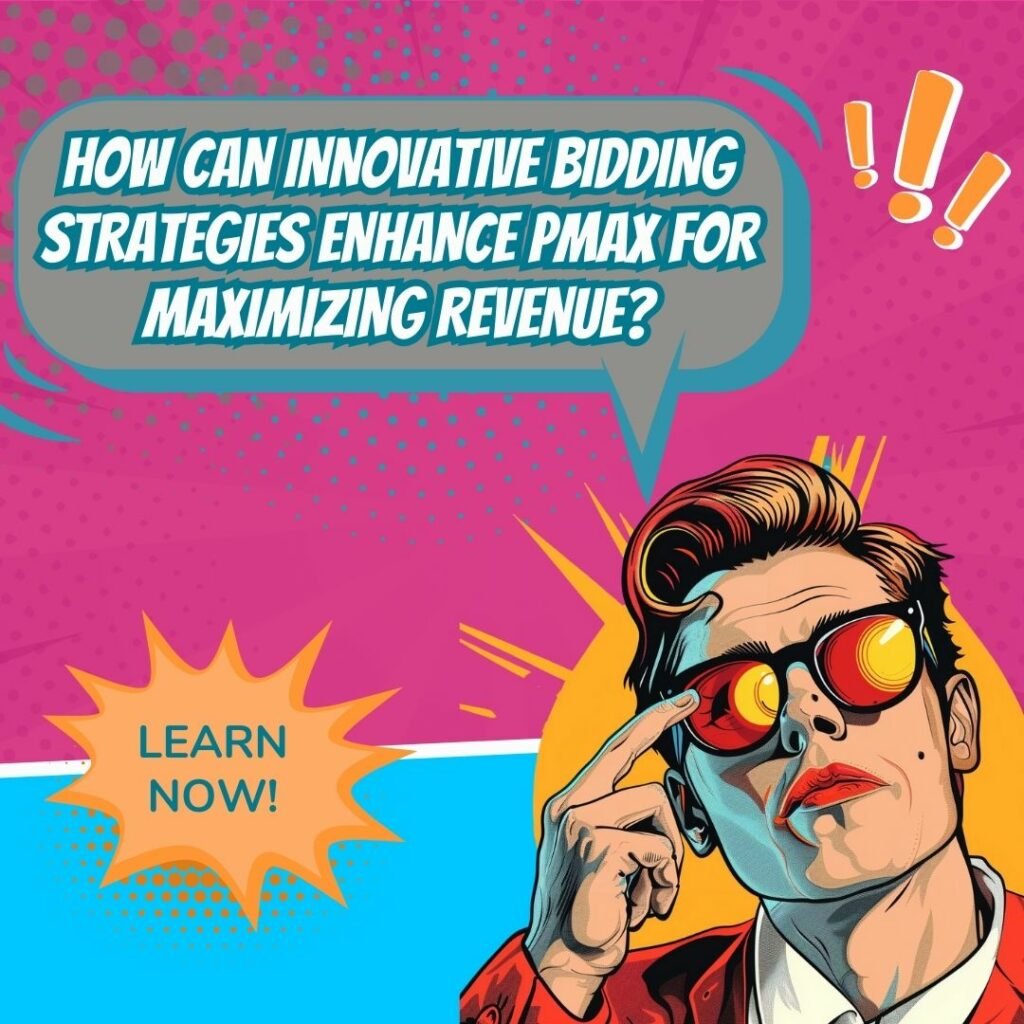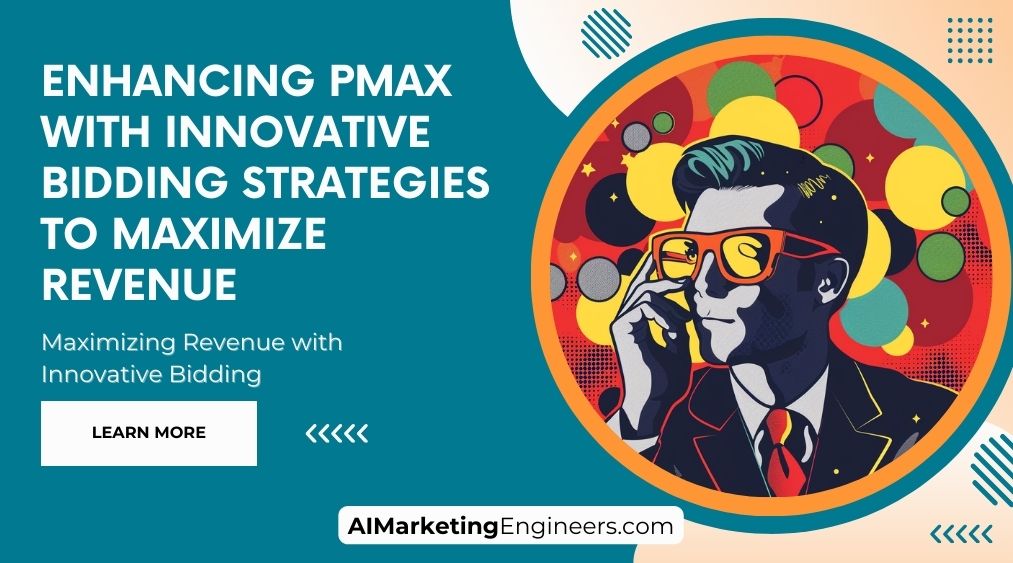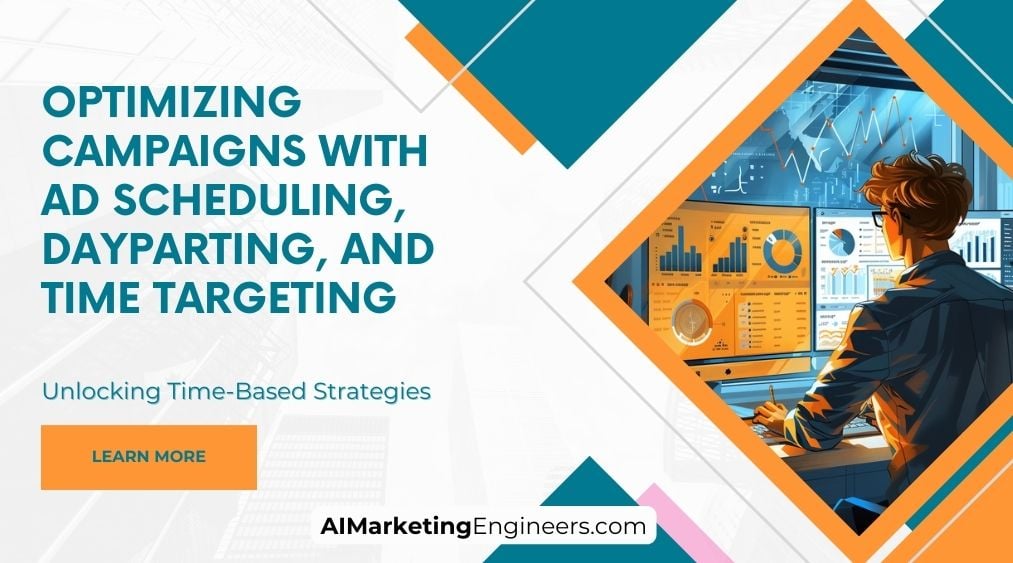Key Takeaways
✅ Optimization for Revenue, Not Just Conversions: While conversions are comforting, pocketing actual profits is the endgame. See, with PMax, it's all about chasing down those sales that make your bottom line blush with pride. We're talking a strategic pivot to eye the prize—pure, unadulterated revenue.
✅ Leveraging Machine Learning and Automation: Imagine having a crystal ball that predicts which bids could make you money hand over fist. Well, with PMax, machine learning is that crystal ball, automating the heavy lifting to place you in front of eyes itching to buy, exactly when their wallets are out.
✅ Customizing Bidding Strategies to Fit Business Goals: One size doesn't fit all, especially in the ad bidding world. PMax is flexible—you can tailor your strategy, whether you're after the biggest bang for your buck or you want as many leads as possible for your hard-earned cash.

Introduction
"Are you keen on making your digital advertising dollars stretch further than ever? Have you considered enhancing PMax with some savvy know-how to maximize revenue? Let's face it; in the bustling bazaar of online ads, crashing into the right strategy could mean the difference between a trickle and a flood of cash flow.
What if we told you that there are ways to make Performance Max not just perform but positively leap off the charts? We'll nudge you through the noise to strategies that not only get you seen but get you paid. We’re unboxing pro-tips that could transform your campaigns into lean, mean, earning machines, tapping into the latest tech that's flicking the switches on buyer behavior. So buckle up—we're about to share some trade secrets that might just be your ticket to the top. Stay tuned for actionable insights and transformative information that could send your revenue rocketing!"
Top Statistics
| Statistic | Insight |
|---|---|
| Performance Max Conversions: Drove 14% of all conversions for advertisers who adopted the strategy in 2020. (Source: Think with Google) | Shows the significant impact of adopting PMax strategies. |
| Digital Advertising Market Growth: Projected to reach $526.17 billion by 2023, with a CAGR of 11.4%. (Source: GlobeNewswire) | Indicates the growing opportunity within the digital advertising space. |
| Automated Bidding in PMax: 68% of marketers believe automated bidding strategies helped achieve performance goals. (Source: Think with Google) | Reflects marketers' trust in automation to meet objectives. |
| Conversion Value Lift with tROAS: Advertisers saw an average lift of 15% compared to manual bidding. (Source: Think with Google) | Highlights the efficiency gains of using targeted automated bidding strategies like tROAS. |
| Programmatic Advertising Market Size: Expected to reach $189.34 billion by 2027, with a CAGR of 13.7%. (Source: Grand View Research) | Suggests a robust growth trajectory for programmatic advertising, hinting at a need for more sophisticated bidding strategies. |
Understanding the Basics of PMax
Have you ever wondered how Performance Max (PMax) campaigns seem to just 'get' what you're looking for online? That's the magic of machine learning and automation at work. PMax campaigns are a kind of digital advertising that Google offers, where your ads reach people across all of Google's channels, like Search, YouTube, and Gmail, all from one campaign. It's like having a Swiss Army knife for your marketing. What makes PMax stand out is how you tell it the kind of customers you're after, and then it uses your info to find them. Think of things like age, interests, what they're searching for – those are your audience signals. And the ads? Well, they're not just your standard banners or text ads. PMax can whip up shoppable ads, display ads, and more, all targeted to meet your campaign goals.
Innovative Bidding Strategies for PMax
So, you've got your PMax campaign up and running. Now what? Ever considered playing around with different bidding strategies? Whether you go for Maximize Conversion Value, Target ROAS (Return on Ad Spend), or Target CPA (Cost Per Acquisition), each one has its own strengths and weaknesses. If you're aiming to get the most bang for your buck, which option should you choose? Well, that really depends on what your campaign is setting out to accomplish. Are you looking to maximize sales, get a solid return on what you're spending, or keep your costs per conversion down? Aligning the right bidding strategy with your campaign's goals is like setting coordinates for your proverbial marketing compass.
Optimizing PMax with Smart Bidding
Speaking of bidding, there's this cool feature in PMax called Smart Bidding. It's basically leveraging Google's brainpower to adjust your bids in real-time, making sure your ad money is being spent wisely. Think of it as having a really smart friend who knows just when to invest more to catch a customer's eye, or when to save a few bucks because the timing isn't right. If you're using PMax, Smart Bidding can help a ton. But here's the kicker – you have to set it up properly. This means giving it the right goals to hit and enough data to learn from. An0d yes, you'll want to keep an eye on it, because every business is a little different, and what works like a charm for one might not for another.
Advanced Tactics for PMax Optimization
Want to step up your PMax game? There are some advanced moves you can try that are much more than hocus-pocus – they're backed by data and testing. Consider broadening your target audience, to possibly uncover folks you might not have thought were interested in your product. Or, take it from the top with ad creative testing, finding out which ads resonate better. Maybe shuffle around your budget based on what's working and what's not. Like any good experiment, it all starts with a hypothesis. What do you think will work better? Test it out, analyze the results, and refine as you go.
Measuring and Analyzing PMax Performance
Now, let's talk about the aftermath. Your PMax campaign's been running; how do you make sense of the results? You've got to keep your eyes on the prize – the key performance indicators (KPIs). There's a pot of data in Google Ads, and it's there to help you understand if you're hitting your targets or if you need to steer the ship a bit. Looking at the numbers, the conversions, the quality of traffic, all of that jazz helps in making informed decisions. Ever heard of "paralysis by analysis"? You'll want to steer clear of that, by focusing on the metrics that truly matter for your goals. Remember, numbers can tell stories, and in the grand tale of your PMax campaign, you want to be the author who writes the next best-selling chapter.
AI Marketing Engineers Recommendation
Recommendation 1: Use Smart Bidding with Historical Data Analysis: Dive into the treasure trove of your past performance data; it's gold! Implement a Smart Bidding strategy that's fed with rich, historical data. How have your customers behaved in the past during different seasons, days of the week, or even hours of the day? Feed this into Google's Performance Max (PMax) campaigns. The AI algorithms can then better predict who's likely to open their wallets and when, possibly showing your ads to these ready-to-spend customers at just the right moments.
Recommendation 2: Align Bidding with Market Trends and Seasonality: Your customers' needs change like seasons – quite literally. Align your bidding strategy with these shifts. Keep a keen eye on market trends, and be ready to adjust your bids for upcoming holidays, sales events, or even weather changes. This means, if it's starting to drizzle, and you sell umbrellas, it’s time to get your ads out there, front and center. Are woolly hats the trend this winter? Adjust your bids to make sure people who are looking to stay warm see your cozy collection first!
Recommendation 3: Leverage Machine Learning Tools for Bid Optimization: Fancy having a crystal ball? Machine learning tools are pretty close. They can forecast outcomes, test different bid strategies, and essentially 'learn' what combination works best for your bottom line. Using tools like Google's automated bid strategies, specifically tailored for PMax campaigns, could be a game-changer. These tools take into account a multitude of signals and can optimize bids in real-time. This means less guessing for you and more precision-targeted ads leading those hopeful clicks straight to your cash register.
Relevant Links
- Maximize Your Campaigns with Google's AI Powerhouse
- SEO in 2024: Stay Ahead of the Curve
- The Rise of AI in Digital Marketing
- Targeting Perfection: Embrace AI in Performance Marketing
- AI Marketing: Transforming Strategies and Customer Connections
Conclusion
So, we've journeyed through the digital landscape of Performance Max (PMax) campaigns, uncovering the significance of innovative bidding strategies along the way. It's time to wrap up what we've learned. Have you ever thought about how squeezing every last drop of revenue from your campaigns could transform your business? That's the power PMax can unleash when paired with the right bidding strategies.
Throughout this exploration, we've seen that machine learning isn't just a fancy term – it's the brains behind optimizing your bids in real-time with Smart Bidding. It can feel like navigating a maze, but when done correctly, your ads can connect with your audience as if by magic. Tailoring bids for Maximize Conversion Value, Target ROAS, or Target CPA can make all the difference depending on your goals.
Why settle for good enough when you can aim for the stars with your campaigns? It’s time to tinker with audience expansion, experiment with ad creative, and not just set a budget but shape it wisely. Measurement and analytics aren't mere checkpoints; they are your compass for maximizing revenue.
Remember, the field of digital advertising never stands still, so neither should you. Leap into action, try out these strategies, keep an eagle eye on the data, and never stop experimenting. Who knows? Your next bidding tweak could be the golden ticket to your PMax campaign's success. Are you ready to take that step?
FAQs
Question 1: What is Enhanced PMax (E-PMax) and how does it differ from traditional PMax campaigns?
Answer: Enhanced PMax (E-PMax) is a new iteration of Google's Performance Max campaigns. It combines multiple advertising channels into a single campaign and uses machine learning to optimize ad placements across Google's inventory, including Search, Display, YouTube, Gmail, and Discover. It differs from traditional PMax campaigns by offering more advanced bidding strategies and features for better performance and revenue maximization.
Question 2: What are the most effective bidding strategies for Enhanced PMax campaigns?
Answer: The most effective bidding strategies for E-PMax campaigns include Maximize Conversion Value, which optimizes bids to drive the most conversion value at a target ROAS; Target ROAS, which sets bids to achieve a specific ROAS goal; Maximize Conversions, which aims to drive the most conversions within a budget; and Target CPA, which targets a specific cost per acquisition.
Question 3: How can I optimize my Enhanced PMax campaigns for better performance?
Answer: To optimize your E-PMax campaigns, it's crucial to use audience signals and customer data to improve targeting, create high-quality, relevant ad assets, closely monitor and adjust your bidding strategies, regularly update conversion goals, and employ automated rules and scripts to manage your campaigns more effectively.
Question 4: What are some advanced tactics for Enhanced PMax campaigns?
Answer: Advanced tactics for E-PMax campaigns include using data-driven attribution, leveraging Smart Bidding strategies, integrating in-depth insights via Google Analytics and Google Ads, experimenting with different ad formats and creative strategies, and conducting A/B tests to determine the best approaches for your campaigns.
Question 5: How can I measure the success of my Enhanced PMax campaigns?
Answer: To measure the success of E-PMax campaigns, focus on metrics like conversion rate, ROAS, CPA, revenue, CTR, and impression share. It's important to regularly analyze these KPIs to ensure you're on the right track and to find areas for optimization.
Question 6: What are some best practices for creating Enhanced PMax campaigns?
Answer: When creating E-PMax campaigns, it's best to clearly define your goals and KPIs, make the most of audience signals, ensure your ad assets are top-notch, use automated bidding for efficiency, keep a close eye on performance and make necessary adjustments, and test various ad formats and strategies to enhance engagement.
Question 7: What are some common mistakes to avoid when setting up Enhanced PMax campaigns?
Answer: To avoid common pitfalls, ensure you're clear on your campaign goals, not neglecting the power of audience insights, maintaining a high standard for your ad content, monitoring and tweaking your bidding strategy as needed, keeping conversion goals up to date, and experimenting with different ad creatives and formats.
Question 8: How can I stay up-to-date with the latest developments and best practices for Enhanced PMax campaigns?
Answer: To stay informed on E-PMax campaigns, follow Google Ads updates, immerse yourself in related industry content, engage with webinars and conferences, connect with online communities, and utilize Google Ads Help Center and support resources.
Question 9: What are some relevant hashtags for Enhanced PMax campaigns?
Answer: You can join conversations and find content related to E-PMax campaigns using hashtags such as #EnhancedPMax, #PerformanceMax, #GoogleAds, #SmartBidding, #ConversionOptimization, #DigitalAdvertising, and #MaximizeRevenue.
Question 10: Can you provide some academic references or case studies on Enhanced PMax campaigns?
Answer: For academic insights and practical case studies on E-PMax campaigns, consider reading resources like "Google Performance Max: A New Campaign Type for a New Era," various articles from Search Engine Journal and WordStream, and check out case studies and thought leadership pieces from Google Ads and Think with Google.
Academic References
- Song, J., Xu, L., & Zhang, W. (2014). Optimal Bidding Strategies for Online Display Advertising. Management Science, 60(11), 2759-2776. This research proposes a mathematical model designed to discover the most beneficial bidding strategies for online display advertising. The key takeaway is the emphasis on balancing revenue with costs by modifying bids in accordance with the likelihood of a user taking the desired action and the potential value derived from such an action.
- Varian, H. R. (2007). Auction-Based Advertising: A Mechanism Design Approach. International Journal of Industrial Organization, 25(6), 1157-1166. Hal Varian offers a thorough examination of auction mechanisms as they apply to online advertising spaces. The paper centers around the challenge of finding equilibrium between the goals of maximizing revenue and maintaining auction efficiency. Varian encourages advertisers to carefully account for elements like bid adjustments, reserve pricing, and budget limits in their strategic plans.
- Li, Z., Li, P., & Zhang, W. (2015). Real-Time Bidding for Display Advertising: Optimal Bidding Strategies and Implications for Advertisers. Marketing Science, 34(2), 259-275. This study delves into the strategic underpinnings of real-time bidding in the sphere of display advertising. The authors devise a strategic model that weighs the value of an advertisement impression, the likelihood of a conversion, and the constraints of the advertiser's budget. The findings reveal that advertisers can bolster their revenue prospects by tactically adjusting bids consistent with the intrinsic value of the impression and the conversion potential.












